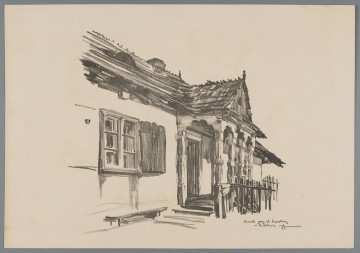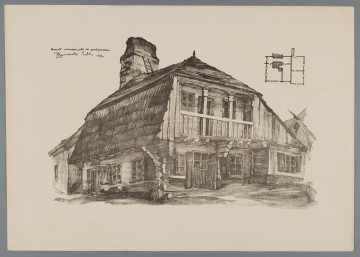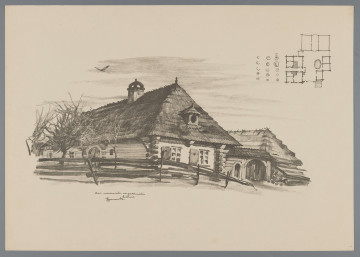
Small house at Szewska street in Lublin
1917 — 1918
National Museum in Lublin
Part of the collection: Lubliniana. Painting views of Lublin and the Lublin Region
Jan Kanty Gumowski studied at the Kraków Academy of Fine Arts under J. Mehoffer, L. Wyczółkowski and K. Laszczka. Already during his studies, he worked at the National Museum in Kraków, making inventories of historical monuments. Gumowski's ability to render precisely the appearance of buildings and the charm of landscapes in Poland resulted in the publication of eight graphic volumes devoted to monuments of architecture and wooden buildings, roadside crosses and chapels, which, apart from the reconstructive approach, are characterized by technical excellence. In 1914, Gumowski joined the Polish Legions, and thanks to the portraits of legionaries and views of battle sites created with great sensitivity, he soon became the draughtsman of the First Brigade. At the same time, he collected materials for the volumes he started before the war. One of the earlier ones he devoted to Lublin, where he came several times in 1916. He arrived here for the first time in September, from Chełm, to convalesce after a bout of disinfection. The artist's subsequent stays in the city lasted until 1917. It was probably then that he made drawings and watercolours documenting the monuments of Lublin, based on which he created a series of fifteen lithographs included in the Lublin portfolio. Motywy architektury polskiej Jana Gumowskiego [Motives of Polish Architecture by Jan Gumowski], b. 3 (1918). On multicolour or black-and-white sheets, he depicted mainly the buildings of the Jewish quarter in Podzamcze, the gates of the Old Town, the buildings of the Kalinowo and Tatary districts. Gumowski constructed his sheets according to the adopted composition scheme, placing the view of a separate building in the centre and sometimes supplementing it with the ground plan. Among the buildings of the Jewish district, the artist's attention was drawn to the house at 6 Krawiecka Street, one of the older and longest streets in Podzamcze, inhabited by the poorest Jews, called luftmenszen, living off the air. The street's specific charm was created by dilapidated wooden houses with characteristic attics, verandas and balconies, which, according to Majer Bałaban, had one thing in common - their roofs with holes, crooked stairs and cracked foundations. The house, which existed until 1923, was characterised by a dovetail construction with extensions, facades in the attic and a picturesque terrace in the gable wall. The artist supplemented the typically documentary drawing with a projection of the layout of the house.
Anna Hałata
Author / creator
Dimensions
cały obiekt: height: 55,6 cm, width: 39 cm
Object type
graphics
Technique
lithography
Material
cardboard
Creation time / dating
Creation / finding place
Owner
The National Museum in Lublin
Identification number
Location / status

1917 — 1918
National Museum in Lublin

1917 — 1918
National Museum in Lublin

1918
National Museum in Lublin
DISCOVER this TOPIC
National Museum in Lublin
DISCOVER this PATH
Educational path